Alignment Service ![]()
 Blue
River Truck Repair Inc., offers TOTAL WHEEL alignment services for trucks and trailers utilizing Hunter Engineering Companies Alignment System.
Blue
River Truck Repair Inc., offers TOTAL WHEEL alignment services for trucks and trailers utilizing Hunter Engineering Companies Alignment System.
TOTAL WHEEL alignment aligns all the axles on a piece of equipment. This includes the steering, drive, tag and trailer axles.
Did you know?
Between 70 and 80 percent of heavy duty vehicles
on the road today are misaligned!
Why is Total Wheel Alignment important?
It takes just a tenth of an inch to have a big impact on your cost!!
For example, what would happen if your rig has toe misalignment of the drive axle by this .10"?
If the mileage is 125,000 miles per year, the resulting effect is the equivalent of dragging the tires sideways for 100 miles!
Using this state of the art Total Wheel alignment system and our trained technicians, we can keep your truck and trailer tracking straight.
Proper Total Wheel alignment is a proven way to:
reduce tire wear
reduce component wear
improve safety
improve handling
minimize rolling resistance.
This translates into fuel and tire savings for you.
Proper alignment does not cost you money, it saves you money.
Call us now to schedule an appointment.
Available for Heavy Duty Equipment with tires sized 18" and up:
Straight Truck
Dump Truck
Bus
OTR Truck
OTR Trailer
Why is alignment so important?
Alignment Angles and Effects
Tire Wear Due to Improper Toe Settings
Toe is the most critical alignment setting for steer axle tire wear. It is measured in inches, millimeters or degrees.
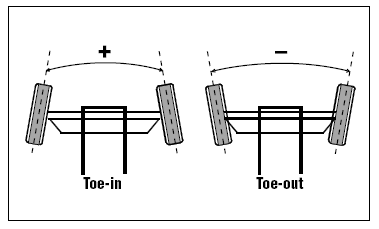
Total Toe is the angle formed by two horizontal lines
through the planes of two wheels. Toe-in is when the
horizontal lines intersect in front of the vehicle; Toeout
is when the horizontal lines intersect behind the
wheels.
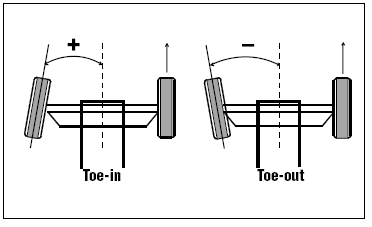
Individual Toe is the angle drawn by a line
drawn through a plane of one wheel referenced to
the thrust line of the vehicle. Toe-in is when the
horizontal lines intersect in front of the wheel.
Toe-out is when the lines intersect behind the
wheel.
Results of excessive toe is wear on the
leading edge of the tire.

Excessive toe-in wears the outside of the tire.
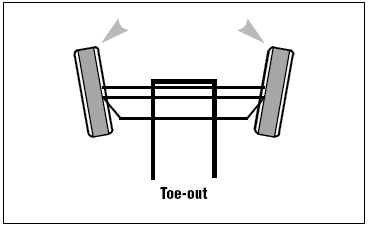
Excessive toe-out wears the inside of the tire.
Tire Wear Due to Improper Camber Settings
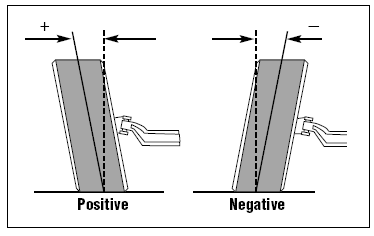
Camber is the angle formed by the inward or
outward tilt of the wheel referenced to a vertical
line. This angle is measured in degrees.
Camber is positive when the wheel is tilted
outward at the top and is negative when the
wheel is tilted inward at the top.

Tire wear from excessive camber: Wear
from positive camber is on the outside shoulder
of the tire; with negative camber, wear is on the
inside shoulder.
Caster: A Factor in Vehicle Handling

Caster is the forward or rearward tilt of the
steering axis in reference to a vertical line. The
angle is measured in degrees. Caster is positive
when the top of the steering axis is tilted rearward
and is negative when the tilt is forward. Caster is
usually a factor in vehicle handling, but can affect
tire wear. Proper caster is important for directional
stability and returnability. Improper caster can
cause shimmy, excessive steering effort, pulling
and shoulder wear on the steer tires.
Turning Angle
Turning angle is the difference in the angles of the front wheels in a turn. This measurement is an aid in diagnosing steering problems and irregular tire wear. Improper turning angle may cause scuffing, leading to excessive tire wear.
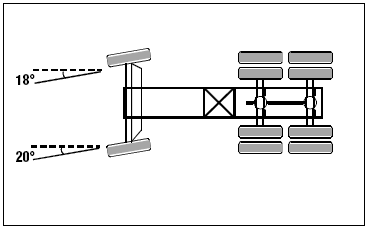
Tandem Axle Angles

Geometric centerline of a vehicle is a line
drawn through the midpoints of the front axle and
the rear reference axle.

Thrust line is the bisector of the total toe
angle of an axle. It represents the direction the
axle “points” compared to the centerline of the
vehicle.
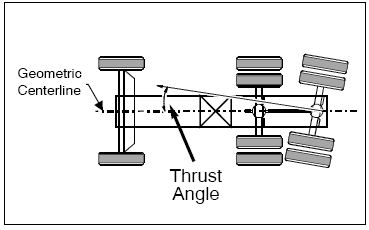
Thrust angle is the angle formed by the
geometric centerline and the thrust line of an
axle.
Tandem scrub angle is the angle formed by the
two thrust lines of a tandem axle vehicle.
In the diagram below, misalignment causes the
tandem axles to work against each other.
The steer axle must be turned to offset the “push”
of the axles and keep the vehicle moving straight
ahead. This causes every tire on the vehicle to
scrub.
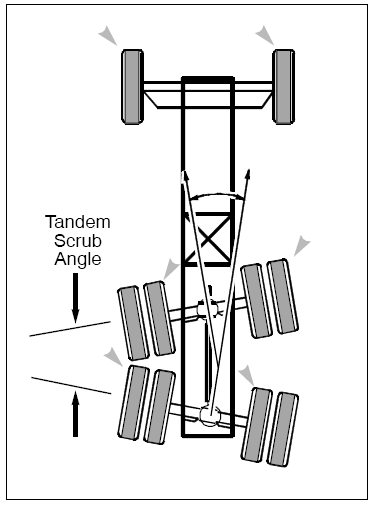
Tire wear from tandem scrub occurs at the
leading edge of the steer tires, in a pattern called
“inside/outside” wear. For example, on the front
axle of this vehicle, wear would occur on the
outside of the left steer tire and on the inside of
the right steer tire. Tire wear would occur on all
drive axle tires.
Trailer Alignment and Tire Wear
The same conditions that cause tandem scrub on tractors also apply to tractor-trailer combinations.
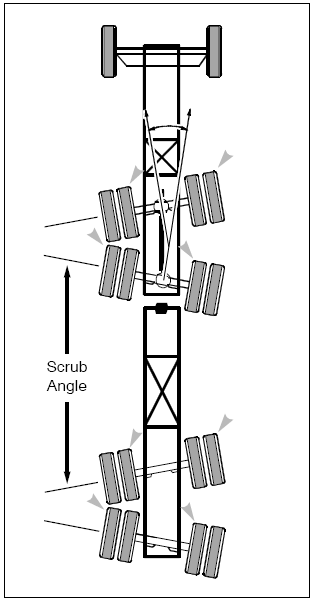
Misaligned trailer axles cause tandem scrub,
resulting in rapid wear on all tires.
If the trailer doesn’t track correctly, it exposes
more area to wind resistance. This can affect
handling and fuel economy.
Alignment Angles Affect Rolling Resistance and Fuel Consumption
Misaligned trailer axles cause tandem scrub, resulting in rapid wear on all tires. If the trailer doesn’t track correctly, it exposes more area to wind resistance. This can affect
handling and fuel economy. While the effects of misalignment show clearly in tire wear, the effects on fuel consumption are less easy to quantify. Fuel consumption is affected by
many factors.
However, it is obvious that misalignment rolling resistance – and rolling resistance is a major cause of fuel consumption.
Geometric Centerline Alignment

Geometric Centerline Alignment can be used as a reference from which to compute individual toe angles. The Geometric Centerline of a vehicle is established by placing a line from the midpoint of the front axle and the midpoint of the rearmost axle.
The Geometric Centerline is not based on frame rails or cross member reference points. The alignment system will establish the Geometric Centerline.
Frame Centerline Alignment
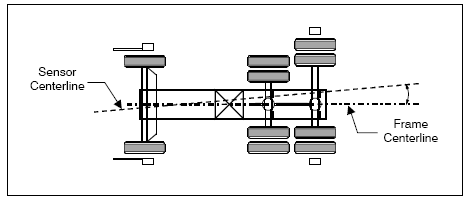
Frame offset angle is the angle of the frame referenced to the sensor centerline. This angle is calculated by the aligner when requested measurements are entered into the aligner.
Separation
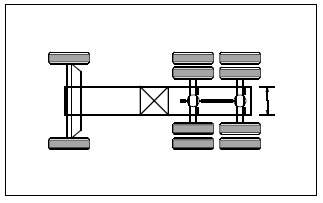
Separation is the distance between the reference axle adjustment points. This distance may be measured and entered into the aligner before adjusting thrust angle to allow the aligner to calculate how much the axle must be moved at the adjustment point.
The full alignment brochure can be downloaded from Hunter Engineering.
